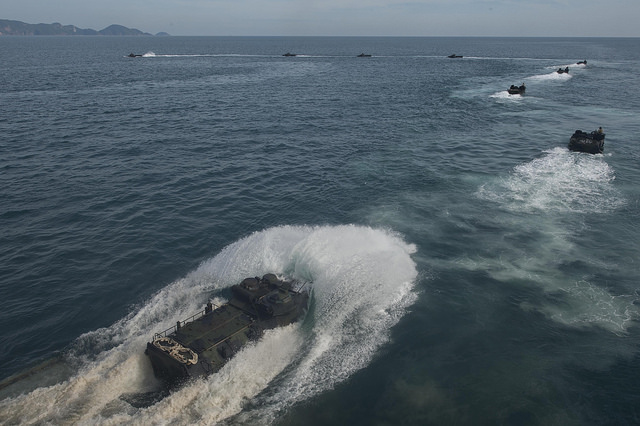
In 2016, the Indonesian government released a white paper outlining the parameters for a future ‘
global maritime fulcrum’ (GMF) strategy. The document reflects the significance of the littoral environment to the country’s national psyche and is indicative of a seafaring tradition that goes back to the 2nd century.
Primarily associated with President Joko Widodo, the GMF seeks to secure Indonesia’s wider maritime interests by capitalising on the state’s unique crossroads position between two oceans (Indian and Pacific) and two regions (Asia and Australasia). Unquestionably ambitious, this visionary program has unfortunately yielded little progress since its inception. Not only has it failed to delineate an appropriate roadmap for meeting its external priorities, but ongoing territorial tensions with Beijing have hindered the GMF’s potential coupling with China’s One Belt, One Road initiative.
The GMF was conceived in light of the numerous threats that plague Indonesia’s archipelagic waters,
including illegal, unregulated and unreported fishing (IUU); pollution; unresolved border disputes; illicit trafficking (arms, humans, drugs); piracy; and terrorism.
A strategy to counter those myriad threats isn’t helped by the vastness of Indonesia’s littoral environment.
To provide even basic coverage of the roughly 6 million square kilometers of combined archipelagic waters and continental shelf and 17,500 islands, it has been estimated that the country would require a fleet of at least 300 vessels operating around the clock.
Adding to Indonesia’s concerns is the growing hegemonic rivalry for leadership in the Asia–Pacific. In particular, Jakarta has become increasingly animated over the possibility of being drawn into the crosshairs of the great power competition between Beijing and Washington.
The aim of the GMF is to fundamentally transform Indonesia’s oceanic realm from what has historically been a security liability into a strategic asset. The policy is predicated on two core assumptions. First, unless the country fully understands, responsibly exploits and studiously manages its waters, a rapidly unmanageable catastrophe will unfold. Second, by effectively leveraging its geographic location, Indonesia can play a decisive role in helping to balance the increasingly fraught relationship between China and the United States.
The GMF consists of
six defining principles and seven pillars, the crux of which can be boiled down to six functional areas: (1) engaging in bilateral and multilateral diplomacy to resolve or at least mitigate border disputes for the common good; (2) tying economic growth to sustainable management of the seas; (3) making large-scale investments in infrastructure to increase connectivity between the numerous islands of the archipelago; (4) creating a coordinating agency that would eventually evolve into a dedicated coastguard; (5) expanding the navy’s green- and potentially blue-water capacities through new equipment and investment in people; and (6) acting as a neutral third party to ensure a balanced regional order in the Asia–Pacific. To pay for the GMF,
Widodo has declared an intention to increase the overall defence budget to 1.5% of GDP within three years (it’s currently less than 1% of GDP).
There’s little doubt that Widodo is sincere in wanting to institute a comprehensive program of maritime domain awareness for Indonesia. The population has also been generally supportive of his agenda, especially the desire to decisively deal with IUU. Sinking foreign vessels that are caught poaching in the country’s waters—
317 have been destroyed since Widodo took office in 2014—sits particularly well with Indonesian nationalism.
That said, little of real substance has been achieved since the GMF was first announced. The only development of note has been the creation of a new maritime security agency (
Badan Keamanan Laut, BAKAMLA). However, even there progress has been halting, largely due to a lack of resources and the inherent difficulty of coordinating 12 self-interested national agencies that have a culture of entrenched rent-seeking.
The GMF’s failure to produce results is mainly due to two factors. First, despite the emphasis on external priorities (using diplomacy to settle border disputes and expanding the navy’s capabilities), the construct is largely silent on exactly
how to configure the country’s military and foreign policy apparatus so that it can meet regional security issues head on. That partly reflects Jakarta’s preference for the principle of non-interference in the internal affairs of other states. However, it also stems from the traditional inward bias in Indonesian strategic thinking and the priority given to maintaining the integrity of the archipelago.
Second, the GMF has been unable to fully leverage China’s One Belt, One Road initiative, which aims to foster greater trade integration between Europe, Africa and Asia. Although President Xi has alluded to the potentially significant role Indonesia could play in actualising that plan, cooperation has been stymied by Beijing’s assertive stance on territorial claims within Indonesia’s EEZ.
Repeated instances of Chinese vessels trawling in the area around the Natuna Islands—which China asserts is within its self-defined nine-dash line and historical national fishing grounds—has been especially contentious, not least because of the importance the Widodo administration has attached to combating IUU.
This ongoing impasse has complicated relations between Jakarta and Beijing and potentially put at risk mutually beneficial arrangements to further their respective maritime plans. However, the cost of failing to align the two strategies will be far greater for the GMF as the various infrastructure projects it envisions—including 24 deep-sea ports that will connect north Sumatra, Jakarta, East Java, South Sulawesi and Papua—will be highly dependent on Chinese investment. Without a resolution of this territorial dispute, Indonesia’s ability to prosecute a viable policy of maritime domain awareness will remain at best questionable and, at worst, unrealisable.
[3] To provide even basic coverage of the roughly 6 million square kilometers of combined archipelagic waters and continental shelf: https://books.google.com/books?id=J1o68XvTSB4C&pg=PA12&lpg=PA12&dq=300+vessels+are+needed+to+cover+indonesia%27s+maritime+space&source=bl&ots=uebzYiKOrT&sig=dqDxcixqfgO6gWowWDJVSWoTwfw&hl=en&sa=X&ved=0ahUKEwjG4oX33tLVAhXiq1QKHZ18A1wQ6AEIMzAC#v=onepage&q=300%20vessels%20are%20needed%20to%20cover%20indonesia
[8] Repeated instances of Chinese vessels trawling in the area around the Natuna Islands: https://medium.com/@dheani/one-belt-one-road-and-global-maritime-fulcrum-between-contradictions-and-harmony-400e473c4b83
 Print This Post
Print This Post